Defensins and cytokins in nail unit affected by onychomycosis: a pilot study
DOI:
https://doi.org/10.12697/poa.2013.22.24Keywords:
onychomycosis, nail biopsy, antimicrobial peptides, defensins, interleikinsAbstract
Onychomycosis is a chronic infection disease that is induced by different types of fungi. Changes of nail color, shape and thickness are disease clinical findings. The disease affects all ages and genders of people, however higher incidence is observed in the people who have reduced immunity.
To study natural immunity of the nail, 22 nail biopsies from onychomycosis patients were taken. Material was stained with hematoxilin and eosin and immunohistochemical methods were used.
We found the nests of hypertrophy in the granulose layer of the epidermis, with focal acanthosis. In the horn layer, we identified the nests of parakeratosis of various sizes, with the incorporations of homogenous and eosinophil masses.
We found high levels of IL-6 and IL-10 positive cells in the bed of the nail and in the bloodstream. IL-1, however, was not a part of any of the functional units of any of the nails. High amount hBD-2-containing fibres was found in the bed and the plate of the nail. Interestingly, hBD-3 and hBD-4 were not found in any of the samples.
So, when it comes to onychomycosis infected nails, the most effective morphopathogenic processes include cytokine and defensin excretion occurs in the bed of the nail.

